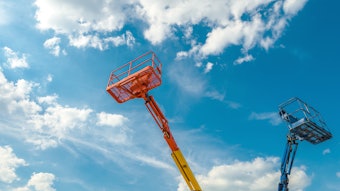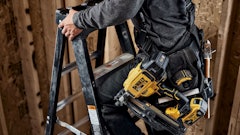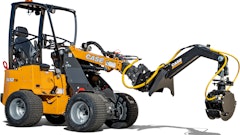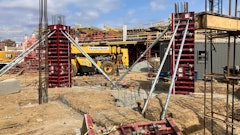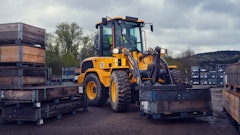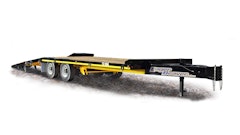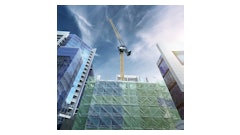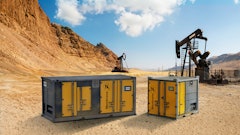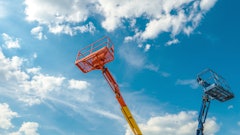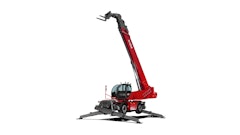A revised ANSI standard for self-propelled boom lifts has rental businesses wondering, once again, what their responsibilities are when renting boom lifts. A recent conversation with Tony Groat, membership development director for Aerial Work Platform Training (AWPT) explains what the new standard does and how it affects rental companies.
For background, the standard referred to in this article is ANSI/SIA A92.5 - 2006 Boom-Supported Elevating Work Platforms. The new standard replaces the previous A92.5 - 1992 standard that was completely reviewed and brought in line with ANSI/SIA A92.6 - 1999 Self-Propelled Elevating Work Platforms, the standard that includes scissor lifts. The new standard became officially effective in August 2006.
RPN: Can you summarize what the new standard is and what it means?
TG: ANSI A92.5 - 2006 is not a new standard, rather a revision of the standard that was last written in 1992. ANSI coordinated the development and use of voluntary consensus standards that provides norms and guidelines for specific business topics. A92.5 was last written in 1992 and the industry committee recognized the need to make changes to the standard. This standard addresses the responsibilities of dealers, owners, users, operators, lessors and lessees of boom-supported elevated work platforms.
RPN: What’s new in the revised standard?
TG: The revision from 1992 is lengthy as it has addressed many areas previously not addressed and provided additional clarity or definition to other areas. Some items of note are:
- The standard added 20 new definitions, most notably "familiarization," which is defined as "providing information regarding the control functions and safety devices for the aerial platforms to a qualified person or operator who controls the movement of an aerial work platform. Likewise, "training" is defined as "instruction to enable the trainee to become a qualified person regarding the task to be performed, including knowledge regarding potential hazards."
- Machine manuals now include the following to be kept and maintained: maintenance manuals, parts manual, repair manual, ANSI manual of responsibilities.
- Change in language from "training on delivery" to "familiarization on delivery." This change delineates the difference between information provided at the time of delivery from general training required prior to use by an operator.
- Record retention has increased from three years to four years and the list of records to be retained has been more clearly defined, specifically requiring proof of training.
- Added language for fall protection addressing the use of either a restraint or an arrest system.
RPN: Can you clarify the difference between training and familiarization and how it relates to rental businesses?
TG: Familiarization is defined as providing information regarding the control functions and safety devices for the aerial platform(s) to a qualified person or operator who controls the movement of an aerial platform. Training is the instruction that will enable an operator to become a qualified person regarding the task to be performed, including knowledge regarding potential hazards, equipment operation, inspection, maintenance and other facets of operation. Familiarization is specific to a machine while training is general to all like machines. In most cases, rental businesses have the responsibilities of both a dealer and user.
As a dealer (an entity who generally sells, rents and services aerial platforms), the rental company shall offer appropriate training to facilitate owners’, users’ and operators’ compliance with requirements defined in the standard. Upon delivery by sale, lease, rental or any form of use, the dealer has the responsibility to familiarize the persons accepting the aerial platform with its operation. The dealer becomes a user when they direct personnel to operate an aerial platform when loading, unloading, inspecting, demonstrating or any other form of use. In the role of a user, the rental company shall ensure that any person they direct or authorize to operate the machine has been trained and familiarized with the equipment.
RPN: How does the new standard affect a rental business’ responsibility when renting boom lifts?
TG: Hopefully, the new standard brings clarity and uniformity in the manner that rental businesses address their responsibilities when renting boom-supported work platforms. The standard may have added the length of time for record retention from three to four years, but realistically, has only defined more clearly the responsibilities that were already in place. If they were not previously understood or being used, hopefully the standard will improve the compliance with required responsibilities in the future.
RPN: How can a rental business best go about meeting the new standard’s requirements?
TG: The standards are industry guidelines, but not the best training tool for implementation. Lift manufacturers, trade associations and training businesses are there to support rental companies in their efforts. The first step is to identify what they are responsible for. The ANSI standards define that. The next step is to create processes and procedures that integrate meeting these responsibilities in their daily work. Then they will need to impart that knowledge within their company to all parties who have accountability to implement their defined processes and procedures. Lastly, they need to audit their procedures for compliance. For the most part, this should already be in place, but for any change or addition in the standard, updates need to be made to bring them into compliance. This standard went into effect August 2006, so this should be completed by now.
RPN: Given the increasingly stringent requirements for training of boom lift operators, what is the future of boom lift rentals?
TG: Boom rentals have increasingly become a common tool of the trade. This voluntary standard will not change the demand in the market for this tool. The change in the standard is in place to assure the competitiveness and quality of life of U.S. businesses. Rental companies need to embrace the requirements and fulfill their responsibilities. Failure to do so will only invite laws and regulation that will mandate how to meet their responsibilities. It is best to follow a consensus standard defined by stakeholders of the industry than by legislation.
For more information on the revised standard, please visit www.ansi.org.
Exclusively online, read how Ironworker programs teach their members how to work safely and efficiently with the highest standards of quality. Read Everyone Wins with Ironworker Training online.

